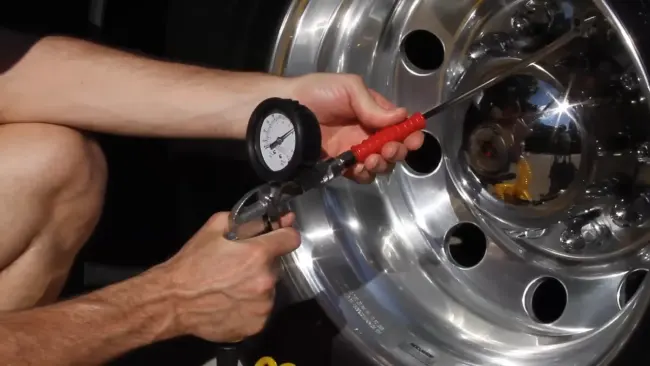Last Updated on September 25, 2023
Inflating dual RV tires is crucial for a smooth and safe journey. Properly inflated tires help maintain optimal performance, increase fuel efficiency and ensure a longer lifespan. But, maintaining tire pressure can be challenging, and many RV enthusiasts often need to pay more attention to this upkeep aspect.
When inflating RV dually tires, ensure you have the necessary equipment, such as an air compressor and a tire pressure gauge. Also, ensure proper rim alignment before inflating the tires. Aside from that, always check the tire pressure using a gauge to ensure it’s at the recommended level.
Today we will discuss inflating your RV dually tires and ensuring a smooth & safe journey ahead. So, buckle up and let’s revitalize your journey and ensure a smooth ride every time.
How to Inflate Dual RV Tires: Step By Step Guide
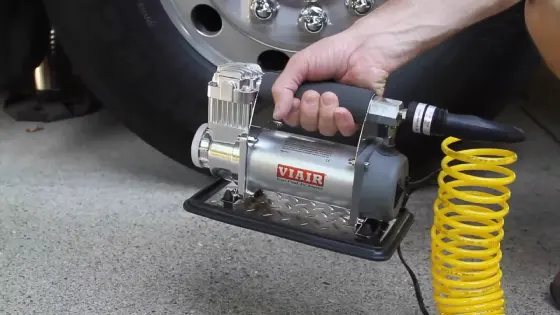
When inflating dual RV tires, there are several key points to remember. But first, make sure you have the right equipment, like a tire pressure gauge and an air compressor.
- STEP 1. Equipment needed for inflation
- STEP 2. Rim alignment
- STEP 3. Checking tire pressure
- STEP 4. Accessing the inner valve stem
- STEP 5. Attaching the inflator chuck
- STEP 6. Inflating the outer tire
- STEP 7. Inflating the inner tire
- STEP 8. Using a tire pressure gauge
- STEP 9. Replacing valve caps
- STEP 10. Regular tire maintenance
STEP 1. Equipment Needed for Inflation
Ensures you have all the necessary equipment to inflate your dual RV tires. To properly inflate your tires, you’ll need a few key items. You’ll need a tire pressure gauge to measure the tire pressure accurately. This will ensure that your tires are pressured to the correct level.
Also, you’ll need a 12-volt air compressor to provide the necessary air pressure to inflate the tires. Ensure the air compressor is compatible with your RV’s tire valve stems. Aside from that, you need an air hose with a suitable attachment to connect the air compressor to the tire valve stems.
STEP 2. Rim Alignment
Ensuring proper rim alignment is crucial for maintaining your vehicle’s optimal performance and longevity. When inflating dual RV tires, it’s important to pay attention to the alignment of the rims to avoid any potential issues. Here are three reasons why rim alignment is important:
- Improved handling: Proper rim alignment ensures your RV maintains stability and control on the road. Misaligned rims can cause your vehicle to pull to one side, making it difficult to steer and maneuver.
- Even tire wear: When the rims are aligned correctly, the vehicle’s weight is distributed evenly across the tires. This helps prevent uneven tire wear, ensuring your tires last longer and providing better traction.
- Fuel efficiency: Misaligned rims can cause increased rolling resistance, decreasing fuel efficiency. Ensuring proper rim alignment can optimize your RV’s fuel economy and save money on gas.
STEP 3. Checking Tire Pressure
To get an accurate reading, check your vehicle’s tire pressure regularly. Maintaining the proper tire pressure is crucial for safe driving and extending the lifespan of your tires. Here is a simple step-by-step guide to help you check the tire pressure of your dual RV tires:
| Steps | Tips |
| 1. Use a tire pressure gauge | Ensure the gauge is compatible with your RV’s tire pressure range. |
| 2. Remove the valve cap | Unscrew the valve cap from the tire’s valve stem. |
| 3. Press the gauge onto the valve stem | Apply firm pressure to get an accurate reading. |
| 4. Read the pressure | The gauge will display the tire pressure in PSI. |
| 5. Inflate or deflate as needed | Add or release air until you reach the recommended pressure for your RV’s tires. |
STEP 4. Accessing the Inner Valve Stem
You’ll need to remove the outer valve cap by simply unscrewing it to access the inner valve stem. Once the cap is off, follow these steps to access the inner valve stem successfully:
- Use a valve stem removal tool or a small pair of pliers to unscrew the valve core from the stem. This will allow air to escape from the tire.
- Position the valve stem to allow easy access to the inner valve stem. You may need to rotate the tire or use a mirror to locate it.
- Once you have a clear view of the inner valve stem, use a valve stem extension or a dual head chuck to inflate the tire. Make sure to check the recommended tire pressure and inflate accordingly.
STEP 5. Attaching the Inflator Chuck
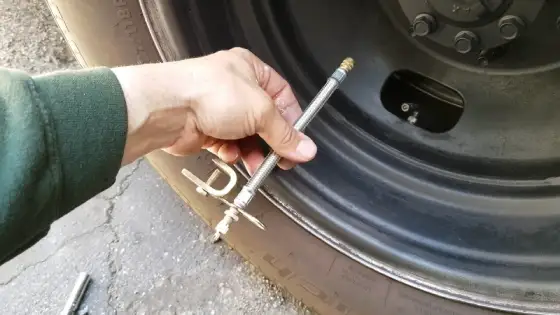
Attach the inflator chuck to the inner valve stem by firmly pressing it onto it until it’s securely in place. Ensure the chuck is aligned properly with the stem to prevent air leaks.
Once the chuck is in position, hold it firmly with one hand while using the other hand to turn the lock ring clockwise to secure it. This’ll ensure a tight seal and prevent air from escaping during inflation.
Once the chuck is securely attached, you can connect the air hose to the chuck. Make sure the connection is tight and secure to prevent any air leakage. Now you can inflate the dual RV tires to the recommended pressure level.
STEP 6. Inflating the Outer Tire
Now that you’ve attached the inflator chuck, it’s time to move on to the next step: inflating the outer tire. This is an important part of the process as it ensures that both tires are properly inflated and ready for the road ahead.
To complete this step, follow these four simple steps:
- Start by turning on the air compressor and adjusting the pressure to match the recommended PSI for your RV tires.
- Place the inflator chuck onto the valve stem of the outer tire and press it firmly to create a tight seal.
- Once the chuck is securely attached, turn the air compressor on and allow the tire to inflate.
- Keep a close eye on the pressure gauge and stop inflating when the tire reaches the recommended PSI.
STEP 7. Inflating the Inner Tire
Once you’ve conquered the outer tire, it’s time to give the inner tire a little love and make sure it’s ready to roll. Start by removing the valve cap from the inner tire and attach the air hose to the valve stem. Make sure the valve stem is secure and not leaking any air.
Now, check the recommended tire pressure for your RV in the owner’s manual or on the tire’s sidewall. Set the air compressor to the correct pressure and inflate the inner tire. Keep an eye on the pressure monitoring gauge and stop inflating once it reaches the recommended level.
Finally, remove the air hose, replace the valve cap, and double-check for leaks. Your dual RV tires are now properly inflated and ready for your next adventure.
| Tire Position | Recommended Pressure (PSI) |
| Outer Tire | 80 |
| Inner Tire | 110 |
| Spare Tire | 80 |
| Steer Axle | 95 |
STEP 8. Using a Tire Pressure Gauge
Feeling confident about your tire pressure is essential for a smooth and worry-free journey. When inflating the dual RV tires, using a tire pressure gauge is crucial. Here are three reasons why:
- Accuracy: A tire pressure gauge provides you with precise readings, ensuring that your tires are inflated to the correct pressure. This is important for maintaining tire performance and safety on the road.
- Preventing overinflation: Overinflated tires can lead to uneven wear, reduced traction, and an uncomfortable ride. Using a tire pressure gauge, you can avoid overinflating your dual RV tires and extend their lifespan.
- Saving fuel: Properly inflated tires improve fuel efficiency. With a tire pressure gauge, you can confirm that your RV tires are at the recommended pressure, helping you save money on fuel during your travels.
STEP 9. Replacing Valve Caps
To ensure a secure seal and prevent air leaks, replacing the valve caps on your tires regularly is important. Valve caps are a protective barrier, preventing dirt, dust, and moisture from entering the valve stem, which can lead to corrosion and potential air leakage.
When inflating your dual RV tires, take a moment to inspect the valve caps for any signs of wear or damage. If you notice any cracks, splits, or missing caps, you must replace them immediately. Simply unscrew the old valve cap and screw on a new one tightly.
Remember, a secure valve cap helps maintain proper tire pressure and ensures the longevity of your tires, ultimately contributing to a safer and smoother RV journey.
STEP 10. Regular Tire Maintenance
Now that you have replaced the valve caps, it’s time to move on to the next important step: regular tire maintenance. This crucial step will ensure the longevity and performance of your dual RV tires.
By properly maintaining your tires, you can prevent potential issues such as blowouts and uneven wear. Regular maintenance includes checking the tire pressure regularly, rotating the tires every 6,000-8,000 miles, and inspecting for any signs of damage or wear.
To make it easier for you, here’s a helpful table outlining the recommended tire pressure for different RVs:
| RV Type | Front Tires (psi) | Rear Tires (psi) |
| Class A | 85-100 | 85-100 |
| Class B | 50-60 | 50-60 |
| Class C | 50-75 | 50-75 |
What PSI should my RV dually tires be?
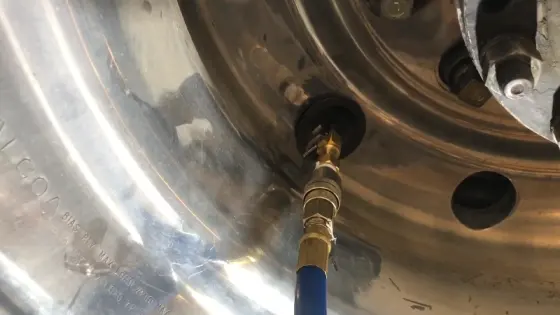
When inflating your RV dually tires, it’s important to know that the recommended PSI should be around 80 for optimal freeway cruising. This means you should aim for a tire pressure of 80 pounds per square inch (PSI) when inflating your dual RV tires.
However, it’s worth noting that the minimum required PSI for around-town driving is 70. So, if you drive mainly in the city, you can stick to the minimum requirement. But if you’re planning on hitting the freeway, it’s best to inflate your tires to around 80 PSI.
Properly inflated tires not only ensure a smoother ride, but they also help improve fuel efficiency and overall tire performance. So, take the time to regularly check and maintain the correct tire pressure for your RV dually tires.
How do I know how much air to put in my RV tires?
Maintaining the proper air pressure in your RV tires ensures optimal performance and safety on the road. To know how much air to put in your RV tires, refer to your RV’s certification label or consult your owner’s manual. These sources will provide the recommended inflation pressures for your specific RV tires.
Another helpful tool to use is a Tire Pressure Monitoring System (TPMS). A TPMS will constantly monitor the tire pressure and alert you if it falls below or exceeds the recommended levels.
This way, you can ensure that your RV tires are always properly inflated, reducing the risk of tire damage, blowouts, and poor handling.
Can I Use Solar Power to Inflate My Dual RV Tires?
Looking to inflate your dual RV tires using solar power? While solar panels can provide energy for various RV appliances, inflating tires requires a different setup. However, by adding more solar panels to rv, you can increase overall power supply and subsequently enhance the overall efficiency and capability of your vehicle’s electrical system. Remember to consult with professionals for the best installation guidance.
Should I inflate my RV dual tires to max psi?
To ensure optimal performance and safety, not going overboard with the air pressure on your RV dual tires is crucial. Stick to the recommended maximum PSI rating imprinted on the sidewall.
Inflating your RV dual tires to the maximum PSI has advantages, but it’s not always the best approach. Here are three reasons why you should avoid inflating your RV dual tires to the max:
- Increased risk of tire blowouts: Over-inflating your tires can lead to excessive heat buildup and uneven wear, increasing the risk of a blowout while on the road.
- Reduced ride comfort: Excessively inflated tires can make your RV feel stiff and uncomfortable, leading to a less enjoyable travel experience.
- Compromised handling and traction: Overinflated tires have a smaller contact patch with the road, resulting in reduced grip and compromised handling, especially in wet or slippery conditions.
Is it safe to drive a dually with a flat tire?
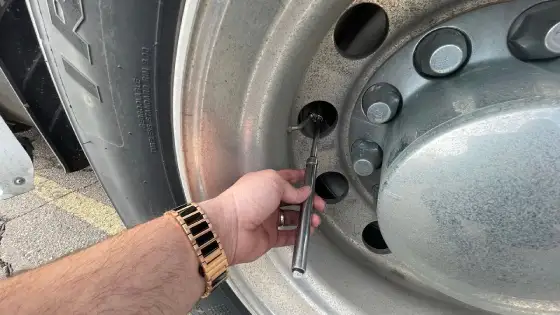
Driving a dually with a flat tire can pose significant risks and should be avoided to ensure your safety on the road. While it’s generally okay to limp slowly somewhere safe on a flat tire with other vehicles, the same can’t be said for a dual or multi-axle trailer.
The extra weight and size of these vehicles make them more difficult to control, especially with a flat tire. Steering becomes challenging, and the risk of losing control increases. Also, the flat tire puts excessive strain on the remaining tires, potentially causing them to overheat and fail.
It’s always best to pull over safely and address the flat tire issue promptly rather than attempting to drive an RV dually with a flat tire.
Improve Your RV’s Performance with Proper Tire Inflation
Maintaining adequate tire pressure is a cornerstone of tire care and maintenance. By checking tire pressure regularly and inflating it to the recommended pressures, you can help increase your RV’s fuel efficiency, elevate its performance, and ensure a longer lifespan for your tires.
Taking the time to inflate and maintain your dual RV tires correctly will ultimately pay off in terms of safety, cost-effectiveness, and an overall smoother journey. So, follow the recommended steps and consult your RV’s owner’s manual to ensure your tires are correctly inflated and ready to hit the road.

